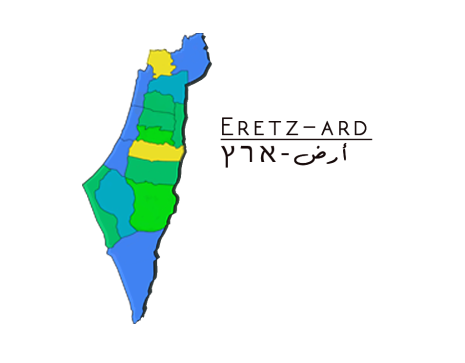
The Eretz-Ard Political Framework is a proposal to resolve the Israeli Palestinian Conflict by means of a Federal Political Model. This solution is meant to provide full equality for both the Jewish and Palestinian people on both individual and collective levels. The key principles are unity of the land and recognition of the connection of both peoples’ historic and cultural ties to the entire land; Mutual Recognition of Indigenous Rights, while providing cultural autonomy for both people within a Federal Political Framework.
The Solution takes the form of a Multi-State Federation model of 16 states, 8 of them having a Jewish majority and 8 of them having a Palestinian majority. The Federal parliament is meant to be bicameral having both a House of Representatives and a Senate with each state having an equal number of Senators and the House of Representatives filled by local representatives based on population.
The Federal government will manage security, foreign relations, health care, a single market economy and a common currency. The individual states can have a great deal of local autonomy with each state having its own democratically elected parliament.
The Eretz-Ard Solution: A Multi-State Federation
- Preserves Regional Autonomy for the Various Ethnic Groups
- Enables a fair distribution of land and resources.
- Encourages cooperation among populations that live near each other.
- Helps preserve parity between the two National Groups.
- Encourages regional economic development.
Eretz-Ard Principles for a Federation in Israel-Palestine
- One country on all of the territory made up of multiple states
- Balanced representation in the parliament between the two groups.
- One Federal Government with a bicameral parliament made up of representatives of the component states
- Executive Branch, President and Chairman with rotation
- Cultural Autonomy for both people based on the principle mutual recognition of indigenous rights and status
- One immigration policy providing right of return for both people
- One capitol in Jerusalem
- One economy providing prosperity for all the people of Israel-Palestine
- One military with no militias
- Regional Integration through a Regional Economic and Security Alliance
The Eretz-Ard Solution: one country on all of the territory made up of multiple states
The United Federation of Israel and Palestine
- 16 States in total
- 8 Jewish Majority States
- 8 Palestinian Majority States
- Total population of the Federation currently around 13.38 Million people
- Current population around 53% Jews and Others (persons with Jewish ancestry who immigrated under the Israeli Law of Return)
- Current Palestinian/Arab population around 47%
Map Design
The distinctive map design is one of the unique features of the Eretz-Ard plan, unlike other plans that often create ‘swiss-cheese’ looking boundaries in order to place a maximum number of Jews on the Israeli side and a maximum number of Arabs on the Palestinian side, we focused on creating a balance in the upper house of the parliament, such that if you gave each state in the federation an equal number of representatives in the upper house, you would get roughly a 50:50 ratio of those elected by Jews and those elected by Arabs/Palestinians.
The main rule of the design was that there are supposed to be an even number of states that have a Jewish Majority as have an Arab/Palestinian Majority. We tried multiple design concepts for the map and did polling to optimize, we started with the most separated version where all the regions had either a large Jewish or large Palestinian majority and only Jerusalem as a ‘mixed region’.
We then tried versions with more mixed regions for cleaner regional boundaries. Then we added additional types of mixed regions that where 2:3 in favor demographically of each side and created a balance between these types of regions for a maximum clean regional boundaries while still providing a balance in terms of regional representation between the groups.
Version 1
The most separated option, with all regions having significant Jewish or Palestinian majorities with only Jerusalem as a ‘Mixed Region’
Version 2
The additional of more ‘Mixed Regions’ allows for cleaner regional boundaries
Version 3 The Eretz-Ard Map
This map incorporated not only ‘Mixed Regions’ but also a balance of regions with a 2:3 majority in favor of each group. Allowing for a balance in representation with the cleanest regional boundaries.
Multiple Categories of States
Based on the current demography:
The Eretz-Ard Map looked at the demographics of the whole Israel-Palestine space as well as taking into account cultural factors within each group. For example on the Palestinian side the culture of Hebron is much more culturally conservative than Ramallah. Similarly in Israel the culture of Jerusalem is much more conservative than Tel-Aviv.
The Eretz-Ard Map
Demography of Israel-Palestine
The Five different categories of States designed to create a demographic balance in the upper house of parliament as well as create boundaries of local regions that reflect local cultural preferences in order to make good social cohesion in the country.
- Blue: 5 Jewish Majority Home States – Current Population Above 80% Jewish
- Green: 5 Palestinian Majority Home States – Current Population Above 80% Palestinian/Arab
- Light Green: 2 Palestinian Majority Mixed States – Current Population Above 60% Palestinian/Arab
- Light Blue: 2 Jewish Majority Mixed States – Current Population Above 60% Jewish
- Yellow: 2 Mixed States – close to 60:40
Culturally Authentic boundaries
Regional boundaries where made with a basis in Israelite Tribal Boundaries as well as historic Palestinian regional boundaries in mind. This was done in order to make the boundaries reflect our traditional culture and feel right to us within our cultural framework. The territories where mainly named after both a major regional city, as the Palestinian regions had traditionally been names as well as a cultural tribal figure. In the norther part of the country these where named after the tribes of Israel and in the south of the country after the traditional Arab Ishmaelite and Qatanite tribes.
Regional Division of Mandatory Palestine
Boundaries of Tribes of Israel according to the Book of Joshua
The Eretz-Ard Map

Map Design for Palestinian/Arab Population of Israel
State of Akka-Asher
- Autonomous region in the Western Galilee; Akka-Asher State.
- Enabling the mixed population of Palestinian/Arab Israelis, Druze, Maronite Christians and Jewish Israelis to have regional autonomy.
- Enabling larger Jewish majority in other regions of Israel.
State of Naba’ot-Shimon
- Autonomous region in the Eastern Negev; Naba’ot-Shimon State.
- Enabling the mixed population of Bedouin Arab and Jewish Israelis to have regional autonomy.
- Resolving land use and environmental issues regarding the Negev region on a local level.
The Gaza Strip:
State of Gaza-Qatan
- Significant expansion of the territory of Gaza; Gaza-Qatan State
- Gives the Gaza-Qatan State Government possession of additional territory to provide affordable housing for Gaza residents.
The West Bank, Judea and Samaria: Beyond the Green Line
- Expands the central mountain territories beyond the Green Line up to highway 6, the beginning of the coastal plain.
- Adds additional Palestinian/Arab Israeli population to the states of Jenin-Menashe and Nablus-Efraim.
- Adds additional Jewish Israel population to the states of Ramallah-Binyamin, Jerusalem-Al Quds and Hebron-Yehuda.
Land Distribution of the States:


Similar to UN Resolution 181 Boundaries:
UN Resolution 181
- Jewish Population 33%
- Palestinian/Arab Population 67%
- Jewish Majority regions 55%
- Palestinian Majority regions 45%
Eretz-Ard Federation Plan
- Jewish Population 53%
- Palestinian/Arab Population 47%
- Jewish Majority regions 53.35%
- Palestinian Majority regions 46.65%
One Federal Government with a bicameral parliament made up of representatives of the component states
- Upper House, the Senate with 64 Senators
- 4 Senators from each state
- Lower House, House of Representatives
- Around 134 House Representatives
- House Representatives based on population from each state, roughly 1 House Representative for every 100,000 people living in each state
- Representation of Jews and Palestinian in the Federal Bicameral Parliament will be close to 50:50
- Federal Government and Constitution protects the rights of minority populations in each state
- 4:5 Majority required to amend the Constitution
House members elected by Districts from each state
District Types:
Blue: Jewish Majority Districts
Green: Palestinian Majority Districts
Light Blue: Jewish Majority Mixed Districts
Light Green: Palestinian Majority Mixed Districts
Purple: Druze Majority Districts
Brown: Circassian Majority Mixed Districts
Red: Maronite Christian Majority Mixed District
Yellow: Mixed Districts Mixed Districts have either a mixed population of Jews and Palestinians or have little to no population and can be used to create new mixed areas in the future.
Structure of the Federation:
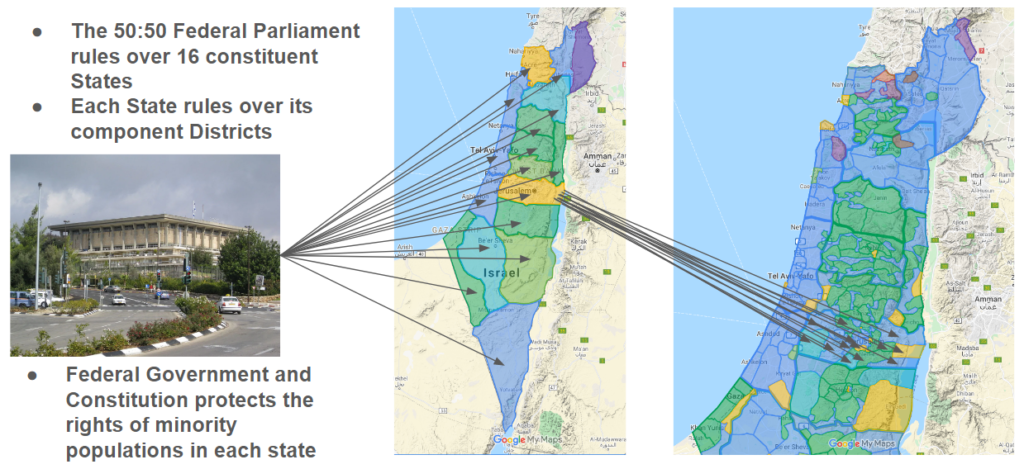
Executive Branch, President and Chairman with rotation
- One President and one Chairman elected as a ticket
- President is Head of State and oversees foreign affairs and is Commander and Chief of the Military
- Chairman oversees internal affairs
- Ministry appointments divided between them and the Parliament
- Elected for a term of four years with rotation after two years
President and Chairman
An Example:
Drake is a Jewish Canadian Rapper and DJ Khaled is a Palestinian American DJ, they have performed several songs together. Let’s say that they both decided to immigrate to the Federation under the laws of return and decided to run for office as a ticket, what would that look like.
Drake – DJ Khaled 2024!
Division of Ministries:
The ministries are divided as follows per the constitution, during the two years during which each elected official holds that office of President or Chairman they are allowed to appoint, meet with regularly and dismiss if necessary the following ministry heads. The Justice Minister, the Minister of Immigration and Integration, the Minister of Religious Affairs and Sacred Sites and the Judges of the Supreme Court are all appointed directly by the Federal Parliament.
President Drake
- Defense
- Finance
- Economy
- Tourism
- Culture
- Science and Technology
- Foreign Affairs
Chairman DJ Khaled
- Interior
- Health
- Education
- Transportation
- Agriculture
- Environmental Protection
- Communications
- Public Security
- Construction and Housing
The Federal Parliament
- Justice
- Supreme Court Judges
- Immigration and Integration
- Religious Affairs and Sacred Sites
Cultural Autonomy for both people based on the principle mutual recognition of indigenous rights:
A Federation of two Nations, where the Nations are the people groups.
- The Jewish and Palestinian people are each recognized as a National Group that is indigenous to the entire country
- Rights to preserve cultural symbols such as flags, anthem and other national symbols
- Rights to preserve language and culture
- Right to education in their own language and culture
- Rights to refer to the country and places in it in culturally authentic ways
- Right to access all historical and religious sites
- Right to self governance through traditional tribal councils in coordination with the Federal Government
Traditional Tribal Councils:
Each national group will have their own Traditional Tribal Councils and National Councils that will work in coordination with the Ministry of Religious Affairs and Sacred Sites as well as other relevant ministries to deal with cultural and religious issues
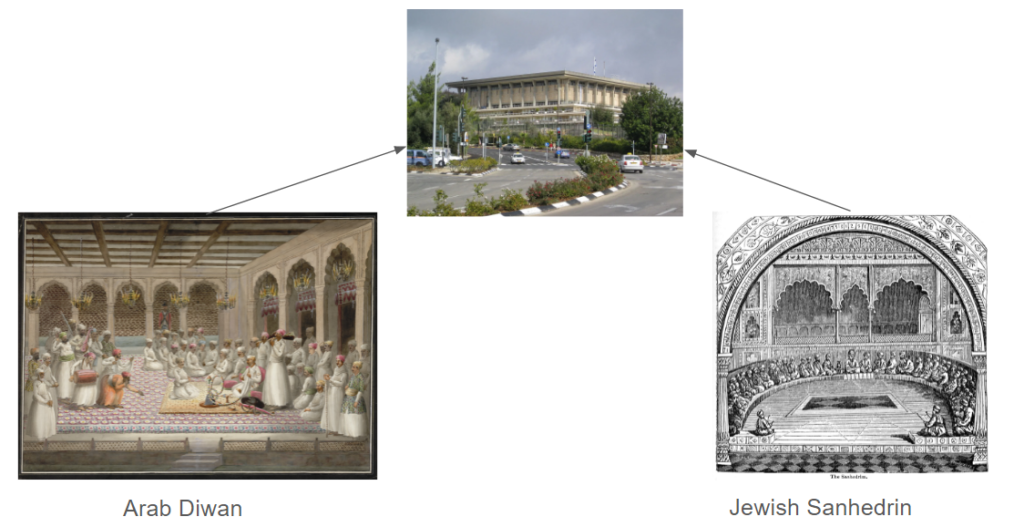
A Modern Sanhedrin: One possible option for Jewish Cultural Autonomy
- Every Jewish Majority District with a population above 500 people will elect a local Sanhedrin of 23 judges, a Traditional Tribal Council
- Each local Sanhedrin will elect one representative to sit on the Great Sanhedrin in Jerusalem, the National Council
- The Great Sanhedrin will elect one member to be the Chief Justice, the Av Beit Din and one President, the Nasi.
- The Local Sanhedrin will work with local authorities and the Great Sanhedrin will work with federal authorities in regards to Jewish cultural and religious issues
- This body would facilitate the Jewish people having cultural and religious autonomy within the federation system.
- The Palestinians could make a similar system or use their current Diwan Tribal councils to function as their mechanism for cultural and religious autonomy.

One immigration policy providing right of return for both people
Jewish Diaspora
- 7.81 Million Jews outside of Israel-Palestine
- Over 20 Million eligible for Israel’s current Law of Return (at least one Jewish grandparent)
- Largest population of Jewish Diaspora is in the United States, 5.7 Million
- Other significant Diaspora populations in France, Canada, the UK and Argentina
- Nearly 3.8 Million Jews have immigrated to Israel since 1918.
Palestinian Diaspora
- 6.36 Million Palestinians outside of Israel-Palestine
- more than 5.6 million Palestinians are registered with UNRWA as refugees, of which more than 1.5 million live in UNRWA-run camps, 710,500 of those live outside of Israel-Palestine
- 3.1 Million Palestinian Refugees live outside of Israel-Palestine
- 2.1 Million Palestinian refugees live in Jordan and almost all Have Jordanian citizenship, less than 200,000 don’t.
- Around 1.2 Million Stateless Palestinian Refugees outside of Israel-Palestine
Immigration to the Federation
- Similar number of Immigrants from both National groups on an annual basis
- Suggested 1% annual immigration rate total, 0.5% from each National Group, starting with 65,000 immigrants from each group per year
- A 20 Year Plan with this rate would enable all stateless Palestinians and those living in Refugee camps to have the opportunity to immigrate.
- The 20 Year Plan would see around 1.8 Million Jews and 1.8 Million Palestinians immigrate to the Federation
- The population growth rate among both Jews and Palestinians is around 2% annual, double the suggested immigration rate
- The population projection following the 20 Year Plan would be around 24 Million people living in the Federation, roughly half Jewish and half Palestinian
Immigration to the Federation and to a State
- Any person who is a citizen at the founding of the Federation or who has lived in the Federation for at least 5 Years is considered a Veteran Citizen
- A Veteran Citizen can move to any state in the Federation to live at any time
- A New immigrant must apply to immigrate to the Federation and to a State
- A New Immigrant can apply to move from one state to another once living in the Federation
- Each state can set criteria for acceptance of New Immigrants from each group
- The Constitution determines a ratio of how many New Immigrants each state may accept from each group.

How a State will work in the Federation
State of Jerusalem – Al Quds: A Case Study
- The State of Jerusalem – Al Quds within the United Federation of Israel and Palestine.
- The State of Jerusalem – Al Quds is a Mixed State as it contains a mixed population of Jews and Palestinians with a current 62.64% Jewish Majority.
- Per the Constitution of the United Federation of Israel and Palestine it is allowed to regulate the number of New Immigrants accepted into the state such that they accept a similar number of New Immigrants from each National Group on an annual basis.
| Area km2 | Jewish Population | Palestinian Population | Non-Arab Christian Population |
| 1,619.872 | 1,061,618 | 632,274 | 967 |
| Total Population | population density | Jewish Population | Palestinian Population | Non-Arab Christian Population |
| 1,694,859 | 1,046.29 | 62.64% | 37.31% | 0.06% |

Federal Representatives:
- 4 Senators for the State
- 17 House Representatives Elected proportionately by District
- Local State Representatives:
- 2 State Senators for each District
- 1 State House Representative for each 25,000 persons in each District
State of Jerusalem – Al Quds:
Distribution of Representatives
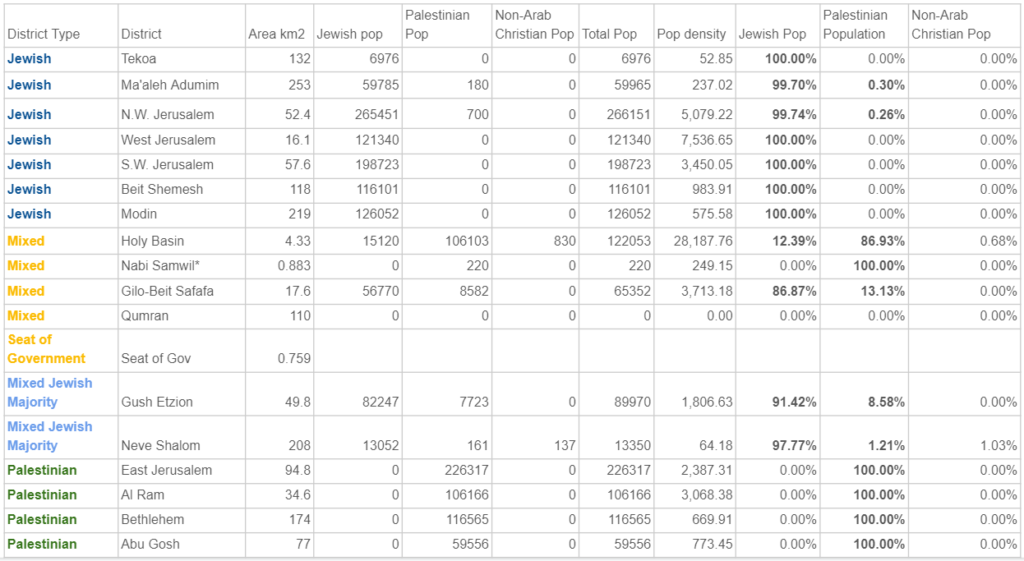
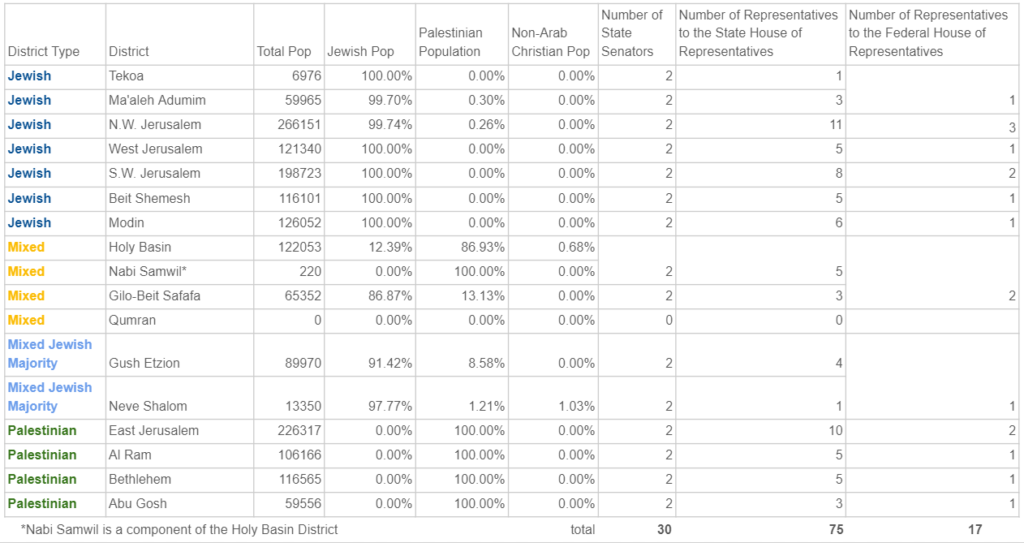
State Representative Breakdown:
| Jewish Population | Palestinian Population | Non-Arab Christian Population | Likely Jewish Senators | Likely Palestinian Senators |
| 1,061,618 | 632,274 | 967 | 3 | 1 |
| 62.64% | 37.31% | 0.06% | 75% | 25% |
| State Senators | State House | Federal House | |||||
| Likely Jewish | Likely Palestinian | Likely Jewish | Likely Palestinian | Likely Jewish | Likely Palestinian | ||
| 20 | 10 | 47 | 28 | 11 | 6 | ||
| 66.67% | 33.33% | 62.67% | 37.33% | 64.71% | 35.29% |
Land Distribution:


One capitol in Jerusalem: New Jerusalem – Al Quds Izjideh
- An Expanded city boundary
- 278 km2
- Current Population 1.1 Million
- More balanced demographics
- More equal distribution of land

Statistics of the New Jerusalem – Al Quds Izjideh


State of Nablus – Efraim: Another Example
- The State of Nablus – Efraim within the United Federation of Israel and Palestine.
- The State of Nablus – Efraim is a Palestinian Home State and it contains a population of Palestinians, Jews and Samaritans with a 83.88% Palestinian Majority.
- Per the Constitution of the United Federation of Israel and Palestine it is allowed to regulate the number of New Immigrants accepted into the state such that they accept a 3:4 majority of New Immigrants from the Palestinian National Group on an annual basis.
| Area km2 | Jewish Population | Palestinian Population | Samaritans |
| 1,088.15 | 132,923 | 694,251 | 450 |
| Total Population | population density | Jewish Population | Palestinian Population | Samaritan Population |
| 826,822 | 759.84 | 16.08% | 83.88% | 0.05% |
State Representative Breakdown:
| Jewish Population | Palestinian Population | Samaritan Population | Likely Jewish Senators | Likely Palestinian Senators |
| 132,923 | 694,251 | 967 | 1 | 3 |
| 16.08% | 83.88% | 0.05% | 25% | 75% |
| State Senators | State House | Federal House | |||||
| Likely Jewish | Likely Palestinian | Likely Jewish | Likely Palestinian | Likely Jewish | Likely Palestinian | ||
| 12 | 32 | 12 | 51 | 2 | 7 | ||
| 27.27% | 72.73% | 19.05% | 80.95% | 22.22% | 77.78% |
Land Distribution

One economy providing prosperity for all the people of Israel-Palestine
Israeli Economy (current)
- Population of 9.05 Million*
- GDP of 394.7 Billion USD
- GDP Per Capita 43,592.08 USD
- Unemployment Rate 5.5%
- Life Expectancy 82.8 Years
- Average Housing Price NIS 1.574 million
- School Enrollment, Tertiary 61%
Palestinian Economy (current)
- Population of 4.33 Million*
- GDP of 16.28 Billion USD
- GDP Per Capita 3,562.33 USD
- Unemployment Rate 27.8%
- Life Expectancy 73.9 Years
- Average Housing Price NIS 0.593 million (Ramallah Area)
- School Enrollment, Tertiary 43%
*Palestinian Population of East Jerusalem counted in Israeli statistics
Economic Projections following the 20 Year Plan
Israel-Palestine Economy (current)
- Population of 13.38 Million
- GDP of 410.98 Billion USD
- 28th largest in the world
- GDP Per Capita 30,900.75 USD
- 31st highest in the world
- Unemployment Rate 12.75%
- Life Expectancy 79.9 Years
- Average Housing Price NIS 1.255 million
- School Enrollment, Tertiary 55.15%
Israel-Palestine Economy (in 20 years)
- Population of 24 Million
- GDP of 998.22 Billion USD
- 18th largest in the world
- GDP Per Capita 41,592.50 USD
- 22nd highest in the world
- Unemployment Rate 6.2%
- Life Expectancy 82.8 Years
- Average Housing Price NIS 1.793 million
- School Enrollment, Tertiary 71.61%
One military with no militias:
The Israel-Palestine Defense Force
- No militias significantly reduces the possibility of sectarian violence
- Built off of the Current Israeli Military
- Gradual increase of Palestinian recruits into the service defending the boarders of Israel-Palestine
- Conscription based military (optional)
- Generating social cohesion and team building experiences
- Creating regional security alliances for greater regional stability
Israeli Military (Current)
- 169,500 active duty personnel
- 29th largest in the world
- 465,000 reserves
- Total personnel 634,500
- 18th largest in the world
- $20.5 Billion USD annual budget
- 14th largest in the world
- 5.3% of GDP
Israeli-Palestine Military (in 20 years)
- 449,500 active duty personnel
- 9th largest in the world
- 1,232,250 reserves
- Total personnel 1,681,750
- 10th largest in the world*
- $52.9 Billion USD annual budget
- 6th largest in the world*
- 5.3% of GDP**
*largest in the Middle East
**can be redirected to other things if security situation allows
Regional Integration through a Regional Economic and Security Alliance
Purchasing the Golan Heights:
- Providing maximum territorial protection
- Access to Mt. Hermon, highest mountain in the Levant
- Offering fair market value for land to Syria and Lebanon
- Renouncing Jewish land claims in Hawran and Daraa
- Offering Economic and Security Alliance with Syria and Lebanon
- Aiding in the process of regional progress and democratization
- Securing citizenship for those Palestinians in Syria and Lebanon who choose not to immigrate to Israel-Palestine, without giving up their Right of Return.
Middle East Regional Economic and Security Alliance:
- Incorporating Israel’s current regional partners
- Free Trade Agreements
- Israel-Palestine Security Umbrella
- Potential for Visa-Free Travel throughout the region
- Regional Stability and Prosperity
For more details please see the Eretz-Ard Political Framework, which is our full federation proposal in the form of a sample constitution for the United Federation of Israel and Palestine.
In addition there is an example constitution for the State of Jerusalem-Al Quds to demonstrate how a State might function within this political framework.
As well you can see a video presentation of the plan summary below.
Downloadable Slideshow Presentation:
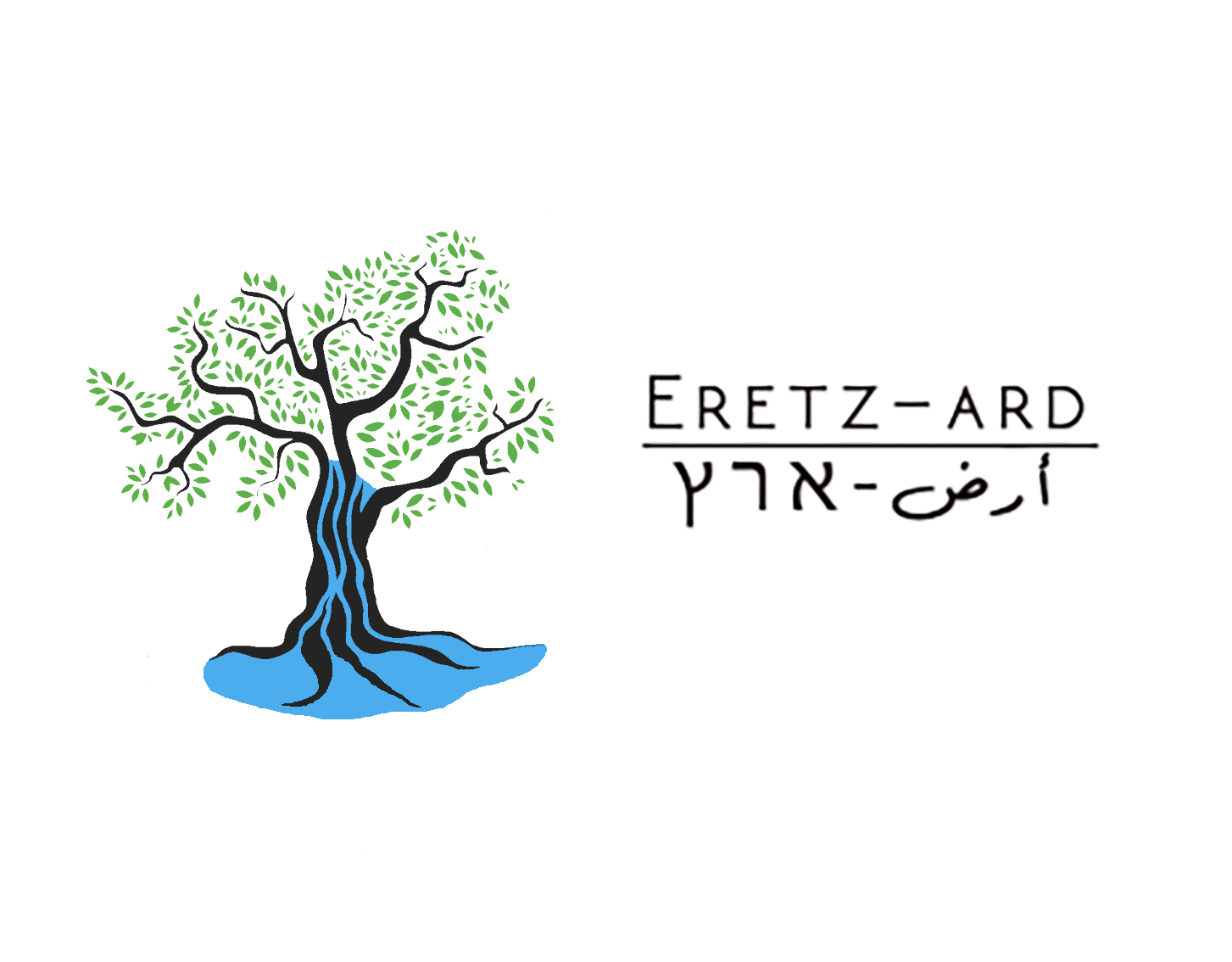
2 responses to “Federation Plan Summary”
In your article, I found the summary of the federation plan very intriguing. Do you think this plan will create genuine collaboration or is it just another framework? I’d love to learn more about the opportunities it offers. If you’re interested in ReactJS and its applications, Click here.
Your writing style makes this topic very engaging. This post is really informative and provides great insights! Your writing style makes this topic very engaging. I can’t wait to implement some of these ideas. I’m bookmarking this for future reference. Excellent post with lots of actionable advice! I’m definitely going to share this with my friends.